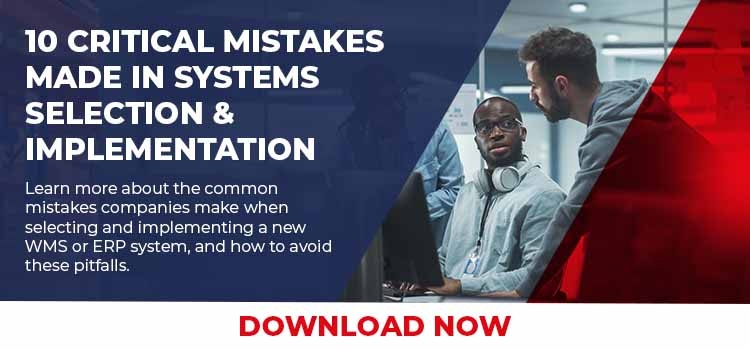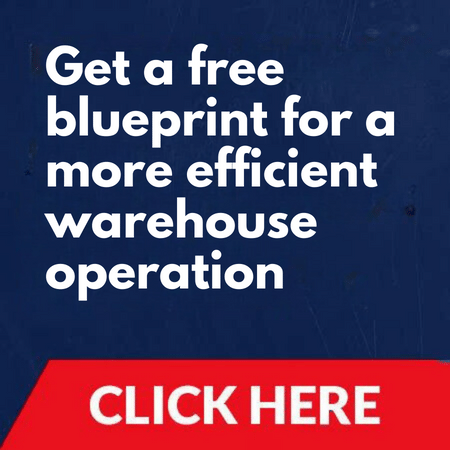Management has decided to upgrade its Order Management System (OMS). The company will look at Enterprise Resource Planning Systems (ERP) as well as industry specific OMS. As the Director of Operations, you will represent the warehousing and distribution functions to ensure the new system fits your needs. How do you know whether your business can benefit from a Warehouse Management System (WMS)? Many warehouses and distribution centers run quite well with warehousing functionality from Order Management Systems (OMS) or Enterprise Resource Planning (ERP) systems. So how do you determine whether a WMS will bring added functionality and benefits? This article will help you sort out the information and productivity advantages that WMS generally have over OMS and ERP.
What Are Your Requirements?
In our consulting practice, we have assisted hundreds of companies with identifying their warehousing and distribution center system requirements and objectively determining the answers to which type of systems fits best. First, it’s always best to analyze your present business and the order and product profiles and the future business that management envisions to determine the functional requirements.
This sounds straight forward. However, we typically see system selection teams immediately call software vendors of a wide variety of systems. The requirements never get thoroughly developed or documented. Therefore, the company doesn’t have written requirements, which are necessary to meet the present and future functions. The discussion with the vendor stays at too high a level:
- “Is your system used to fulfill e-commerce orders?”
- “Do retailers use your system to replenish stores?”
Many vendors can say "yes" with a straight face to those questions.
However, the only important thing for your company is how your detail functions match up to their capabilities and at what investment.
The downside of not doing this homework upfront is that you may not have the full function solution you think you have and will require unanticipated modifications during the implementation process.
Flexible Process Options
As business becomes more multichannel-oriented, the product assortment and order profiles often change dramatically. Brick & mortar retailers today have e-commerce channels. These two channels have widely different needs for carton and pallet oriented units of work versus e-commerce small order pick, pack and ship. These business differences also use different modes of outbound transportation, manifesting and shipping systems. In e-commerce, to build confidence with customers, take back returns and repackage or refurbish products - major customer service functions retail distribution centers never have to deal with.
Third Party Logistics (3PL) fulfillment is becoming more commonplace. 3PL companies need the ability to tailor their warehousing and distribution functionality to their clients’ ever changing requirements.
The warehouse system functionality needs to provide a variety of methods to operate different parts of the operation. It is essential to provide these diverse processes based on a given warehouse, the required functions, warehouse zone, product differentiation, order profile, etc. These varied requirements fall within the flexibility and capability of most WMS products.
Whether it’s complexities from multiple channels or changes in other business functionality, warehouse managers are required to react to these different environments. Distribution center managers are being asked to perform multiple tasks requiring a wide variety of flexible functionality.
The flexibility to manage various tasks for different divisions of the business in the warehouse and apply the appropriate business rules and processes to these various segments separates most WMS software from other OMS or ERP options.
Supply Chain
Retailers and e-commerce companies want more flexibility in their supply chain with their manufacturers and wholesalers. A trend is to push value-added services and functions up the supply chain. Vendor compliance procedures and supply chain systems requirements often vary widely between companies.
What supply chain functionality does your business need? One function that allows the warehouse to better prepare for receiving goods is being able to receive Advance Shipping Notices (ASN). This functionality is usually standard in the WMS applications. ASNs allow the receiving manager to schedule staff and be prepared for deliveries before the truck arrives at the loading dock. The ability to know the scheduled merchandise expected receipt arrival dates and the merchandise that is expected will not only speed up the receiving process but also improve the flow of goods through to put away.
There are major differences in function that are available between many WMS and OMS in supply chain functions.There may be ship direct to stores or cross dock retail supply chain network requirements which e-commerce companies would never need.
Receiving
Receiving is where the systemic warehouse processes begin and what is able to be done effectively, efficiently and accurately in receiving sets the watermark for the rest of the warehouse functionality.
Where does the receiving process start within the application system? Is there interface to Supply Chain? Is there a dock receiving system or does it start downstream entering receipts? Is there RF and scanning of cartons and pallets as a starting point? What critical warehousing functional data is not captured in the system (e.g. vendor compliance, client product inspection or QA)? WMS may provide a higher level of function.
Picking Options
Order picking is one of the major expenses in operations. Applying the most efficient pick functions to your operation increases productivity. Some of the picking options that are available in many WMS packages include:
- Single order pick
- Cart/Bin pick
- Batch pick and sort
- Zone pick
- Wave pick
- Pick and Pass
- Cross Dock
- Dynamic “Hot Pick”
In addition to these traditional picking options, many distribution centers require more technology to improve picking. Voice picking and pick to light have been successfully interfaced or integrated with most WMS software.
One key capability is to preview the order queue to determine what orders are available to be processed. Rather than pushing all orders to the floor as many OMS do, WMS often give you the option to select the order volume or type of orders that you want to process. This often gives you greater ability to manage higher priority pick batches and give more skilled workers more complex order batches.
Inventory Management
Inventory is usually the largest asset in most companies. WMS applications offer advantages over most other systems performing basic inventory control for tracking inventory throughout the warehousing functions and processes – from receiving, inspection, put away, forward pick replenishment, order processing, picking, pack confirmation, shipping, returns processing, etc.
OMS or ERP may not provide the complete range of Radio Frequency (RF) and the use of bar coded locations and product, the ability to dynamically move inventory from one location to another. The status of product in real time gives a more timely and accurate picture of your inventory and its components.
Most Order Management (OMS) and Enterprise Resource Planning (ERP) type systems will support basic physical or cycle counting capabilities maybe only after hours. However, more sophisticated cycle counting methodologies are generally supported through a WMS. Another difference between systems is use of different events to trigger cycle counts. This functionality will achieve greater inventory accuracy and result in less “warehouse back orders or can’t finds”.
Production/Assembly
Your business may require the capability to plan, track and assemble kits. ERP systems may have a manufacturing and multi-level heritage; OMS often have only a single level of kit tracking.
Most WMS software applications have the ability to track the production tasks and manage the component inventory as well as the final assembled products. The ability to track component inventory; plan and track labor usage; and track the status of the work order status are key functionality within most WMS applications today.
Labor Tracking
Another area WMS systems standout from OMS/ERP is in the area of labor usage and tracking. Labor often is more than 50% of the total cost per order when you consider all costs. What labor functions do you need to improve productivity by individual and department? With the ability to capture, and measure and feedback your staff’s performance often leads to increased productivity -as much as 10% to 15%. If you are considering any type of incentive pay, it will require accurate capture and reporting of productivity.
Another labor management aspect is to be able to perform task interleaving to increase productivity by combining multiple operations within a given aisle or zone. This functionality is not normally found outside of WMSs.
Best of Breed Integration
A standalone WMS, either interfaced or integrated to an OMS or ERP systems, is an option many larger companies implement. One advantage that specialized OMS and ERP have over a “best of breed” interface is that all functionality and data bases are seamlessly integrated and allow on-line functions across the enterprise. This on-line integration may not be realistic in an OMS or ERP to WMS integration.
Other WMS Modules
For large and complex warehouse and distribution center environments, WMS may provide other critical functions that OMS and ERP do not have. These may include Demand Forecasting, Transportation Management, Yard Management, Warehouse Space Management (Cube Utilization), Slotting Management, Material Handling Equipment Integration and modules which are options and may only be available with Warehouse Management Systems.
System Tier Levels
Not all WMS are created equal. Software vendor offerings can be separated into tiers of functionality which also correspond to investment. Again develop your requirements and be sure how the offerings differ.
In Summary
Do your homework and get your mission critical requirements documented. Many OMS and ERP systems provide all the warehouse functionality a company may require. Be objective and identify how additional WMS capabilities will increase productivity and reduce warehouse costs. Do these functions require a WMS? Secondly, prepare a return on investment (ROI) and benefits study for an new system. Does WMS give you more feature and function and an ROI?







SHARE